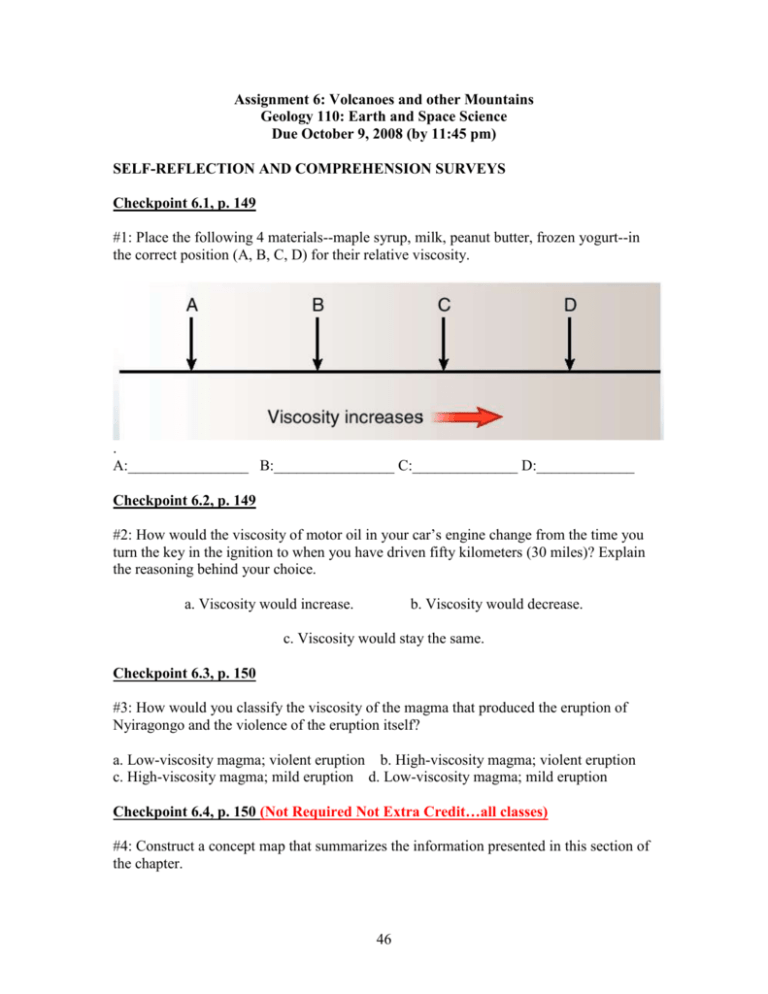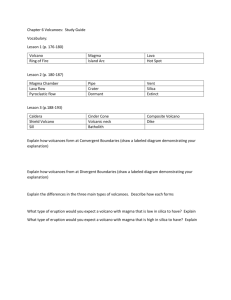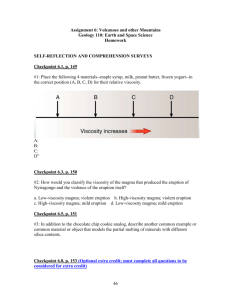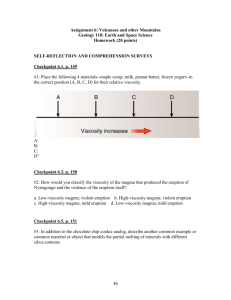GEHomeworkCh6
advertisement

Assignment 6: Volcanoes and other Mountains Geology 110: Earth and Space Science Due October 9, 2008 (by 11:45 pm) SELF-REFLECTION AND COMPREHENSION SURVEYS Checkpoint 6.1, p. 149 #1: Place the following 4 materials--maple syrup, milk, peanut butter, frozen yogurt--in the correct position (A, B, C, D) for their relative viscosity. . A:________________ B:________________ C:______________ D:_____________ Checkpoint 6.2, p. 149 #2: How would the viscosity of motor oil in your car’s engine change from the time you turn the key in the ignition to when you have driven fifty kilometers (30 miles)? Explain the reasoning behind your choice. a. Viscosity would increase. b. Viscosity would decrease. c. Viscosity would stay the same. Checkpoint 6.3, p. 150 #3: How would you classify the viscosity of the magma that produced the eruption of Nyiragongo and the violence of the eruption itself? a. Low-viscosity magma; violent eruption b. High-viscosity magma; violent eruption c. High-viscosity magma; mild eruption d. Low-viscosity magma; mild eruption Checkpoint 6.4, p. 150 (Not Required Not Extra Credit…all classes) #4: Construct a concept map that summarizes the information presented in this section of the chapter. 46 Use standard concept map scoring rubric. Scoring Rubric 0 The concept map does not contain any information about magma and viscosity. 1 The concept map contains some terms that are significant to explain magma and viscosity but several key terms are omitted and many linking phrases are either absent or inaccurate. 2 The concept map contains most terms that are significant to explain magma and viscosity, but they are poorly organized and some linking phrases are absent or incorrect. 3 The concept map contains most terms that are significant to explain magma and viscosity, but one or two key term(s) may be absent. The diagram is reasonably well organized, and almost all linking phrases are appropriate. 4 The concept map contains all terms that are significant to explain magma and viscosity in a well-organized display that has appropriate linking phrases for each pair of terms. Checkpoint 6.5, p. 151 (Not Required, Not Extra Credit…all classes) #5: In addition to the chocolate chip cookie analog, describe another common example or common material or object that models the partial melting of minerals with different silica contents. Checkpoint 6.6, p. 152: Venn Diagram: Magma Composition and Magma Sources (EXTRA CREDIT…all classes) #6: Use the Venn diagram provided to compare and contrast the compositions and sources of the 3 principal types of magma. Write the numbers corresponding to features unique to either group in the larger areas of each circle; note features that they share in the overlap areas. Identify at least 7 more features. Rhyolitic Andesitic Basaltic 47 1. 2. 3. 4. 5. 6. 7. 8. 9. 10. Low silica content From a mantle source Example: Aleutian Island volcanoes Checkpoint 6.7, p. 153: Decade Volcanoes, Part I (EXTRA CREDIT..all classes) #7: The Decade Volcano initiative is part of a United Nations program aimed at better utilizing science and emergency management to reduce the severity of natural disasters. By studying the Decade Volcanoes, science and land-use planning teams are attempting to learn the best ways to reduce the risks to life and property from volcano-related hazards. Answer the following questions using the volcanoes illustrated on the map. It may be useful to review a map of plate boundaries before attempting to answer the questions. a) Underline 5 volcanoes that formed above subduction zones of 5 different plates. b) Are any volcanoes associated with a present-day divergent plate boundary? Yes No c) Name a volcano that generates low-viscosity magma. d) Other than Mauna Loa, which volcano is most likely to have formed above a hot spot? 48 Checkpoint 6.8, p. 153 #8: Go to www.volcano.si.edu/reports/usgs/ to obtain the Smithsonian/USGS weekly volcanic activity report. Click on the world map link and compare the location of each volcano with a map of plates (Fig. 4.21) to predict the type of magma generated at each location. Write a one-sentence summary for each location to describe the volcanic activity. Is there any relationship between the type of activity at each volcano and the plate tectonic setting? Checkpoint 6.9, p. 154 #9: Predict the type of magma associated with Mt. St. Helens. a. Andesitic b. Basaltic c. Rhyolitic Checkpoint 6.10, p. 155 #10: Earthquakes and Mount St. Helens Volcanic eruptions are often preceded by earthquake activity as magma rises upward through the crust underlying the volcano. Examine the graphs of earthquake events for 1980 (graph a) and for 1981-1991 (graph b). How did earthquake activity differ for the two intervals? Checkpoint 6.11, p. 157 (EXTRA CREDIT…all classes) #11: Identify elements of the scientific method in the analysis of Mount St. Helens that preceded the eruption. Checkpoint 6.12, pp. 158-159: People and Mount St. Helens’ Exercise (YOU HAVE A CHOICE OF COMPLETING THIS QUESTION OR QUESTION #16 ON MOUNT SHASTA…ALL CLASSES…note for online class: the question you pick will be for your notebook) 49 #12: Examine the following descriptions to compare the actions of scientists, government agencies, businesses, and the general public in the weeks preceding the eruption of Mount St. Helens. How did the different constituencies perceive the threat of an eruption? Create a diagram that illustrates how the different constituencies perceived the threat from the volcano over the 2-month period from March 20-May 18. What do you think would have happened if the main eruption had not occurred for another 2 months? Keep in mind that the job description for scientists of the USGS prevents them from recommending specific actions to lessen risk, but requires them to focus on assessing natural processes and forecasting geological scenarios. Local, regional, and federal governments are responsible for instituting measures to protect populations and structures, while taking into account cultural and social factors. Early Days (March 20-April 2) Scientists: USGS adds more seismometers and warn of earthquakes related to volcanic activity; gas and ash samples interpreted to indicate a magma source near surface; more instruments added. Government Agencies: The U.S. Forest Service (USFS) warns the public to stay away and closes Spirit Lake; Federal Aviation Administration (FAA) imposes flight restrictions; evacuation within 24-km (15 mile) radius; National Guard sets up 29 roadblocks; USFS moves possessions of staff from evacuated area. Business: 300 loggers return to work on northwest flank of volcano. Public: Sightseers crowd nearest viewing sites; citizens express frustration from being kept from property. Local cabin owner Harry Truman refuses to leave, saying “I think the whole damn thing is over-exaggerated … You couldn’t pull me out with a mule team.” Unrest Continues (April 3-April 18) Scientists: Geologists identify the greatest hazards of potential eruption as flooding or mudflows; costs of monitoring volcano and maintaining safety forces continues to rise; USGS reduces number of scientists at volcano from 30 to 10. Government Agencies: Governor declares state of emergency; roadblocks moved farther from volcano; some roadblocks removed because of a reduction in unrest and public harassment; National Guard staffing reduced. Business: Loggers request more access to restricted areas; local businesses threaten to sue if roadblocks are not moved closer to mountain. Public: 109 planes reported inside restricted air space on one day; tourists flock for closeup view of the mountain; climbers evade roadblocks and reach peak. 50 Danger Threatens . . . Maybe (April 19-May 3) Scientists: Bulging of north flank becomes more obvious; seismic activity increases; high concentrations of SO2 noted; geologist comments, “It’s very dramatic to see this much ground motion. It can’t be anything but some type of dramatic change going on inside the mountain.” Government Agencies: Red Cross takes disaster workers off standby alert and asks county to return all extra shelter equipment. Governor closes red zone within 12 kilometers of mountain except for scientists and law enforcement; areas within 25 kilometers only accessible for land owners and loggers. Business: Timber company considers blocking active logging roads to restrict tourist access, citing concerns over potential problems with congestion, fires, and accidents with logging trucks. Areas within 25 kilometers accessible only for landowners and loggers. Public: Emergency services personnel frustrated because public appears unaware of the danger: “The mountain looks so serene, so people can’t fathom 4,000 vertical feet of Earth, rock, and ice plunging into (Spirit Lake) in less than 2 minutes.” The End is Nigh? (5/4-5/17) Scientists: USGS Geologist “(the deformation) is continuing at a very high rate. Sometime it has to go. We just don’t know how much longer it can last”; USGS stops taking measurements high on mountain due to increased danger from sudden avalanches. Government Agencies: FAA officials issue a pilot’s warning that an ash plume extended 32 kilometers (20 miles) to the north-northeast and was “of extreme hazard to aircraft”; governor grants request for 50 landowners to retrieve possessions. Business: Logger quoted as saying “We’re logging 10 miles away from the peak.… I don’t see any hazard. I just came back from Hawaii, where they run tourist buses right up to the edge of a venting volcano.” Public: Tourists from around the world come to see the mountain; owners of property in evacuation zone near volcano demand access to homes. May 18 At 8:32 AM an earthquake shook Mount St. Helens volcano, resulting in a giant rockslide from the area of the bulge on the north flank. The landslide is followed by a major eruption that blasted nearly 400 meters of the peak into the atmosphere. Approximately 650 square kilometers of surrounding lands are damaged by a lateral blast, and 150 51 million cubic meters of material are deposited directly by lahars (volcanic mudflows) into the river channels. Fifty-seven people are killed or are still missing. The initial volcanic blast destroys forest lands and property within the cordon of roadblocks. Explosive eruptions continue until October but none reach the magnitude of the May 18 event. Checkpoint 6.13, p. 162 (NOT REQUIRED NOT EXTRA CREDIT…all classes) #13: Trees were knocked down up to 27 kilometers (17 miles) from Mount St. Helens by the blast associated with the eruption. Where would a volcano in your region be if it were 27 kilometers from your home or college? Checkpoint 6.14, p. 166 (EXTRA CREDIT…ALL CLASSES) #14: Venn Diagram: Mount St. Helens and Nyiragongo Compared Use the Venn diagram provided here to compare and contrast the eruptions of Nyiragongo and Mount St. Helens. Write the numbers corresponding to features unique to either group in the larger areas of the left and right circles; note features that they share in the overlap area in the center of the image. Mount. St. Helens 1. 2. 3. 4. 5. 6. 7. Nyiragongo Located near a convergent plate boundary. Located near an early-stage divergent plate boundary. Produced significant lava flows. Eruption followed a century of inactivity. Several eruptions in the last century. Few monitoring instruments prior to unrest. Volcanic gases released prior to main eruption. 52 8. Frequent earthquakes associated with unrest. 9. Unrest lasted for approximately 2 months before eruption. 10. Eruption occurred in daylight. 11. Volcano located within 20 km of large city. 12. Volcanic activity subsided after about 1 week. 13. Low-viscosity magma. 14. USGS geologists aided in interpretation of volcanic activity. 15. Death toll less than 100. 16. Death toll more than 100. 17. Shape of volcano changed prior to eruption. 18. Eruption characterized by a massive lateral blast. . Checkpoint 6.15, p. 166 #15: Compare and contrast the consequences of a major earthquake and a volcanic eruption with a VEI of 5. Imagine that you were mayor of a city that was located within 30 kilometers of the epicenter or volcano and that you had evacuated the residents prior to the earthquake or eruption. Which aftermath would you prefer deal with and why? Checkpoint 6.16, p. 167 (SEE NOTE ABOVE at question #12) #16: Read the following description of the eruption history of Mount Shasta and answer the questions that follow. Mt. Shasta Volcanic History Mount Shasta in northern California is a stratovolcano consisting of overlapping cones centered at four main vents. Eruptions produced andesite lava and pyroclastic flows. During the last millennium, Mount Shasta has erupted on the average at least once every 250 years. The most recent eruption occurred in 1786 A.D. Lava flows issued from vents near the summit and from vents on the slopes of the volcano. Individual lava flows are up to 13 kilometers (8 miles) long. No lava flows extended for more than 20 kilometers (12 miles) from the summit. Pyroclastic flows from the summit and the Shastina vent (see map) have traveled distances of more than 20 kilometers. Other vents produced flows that extended up to 10 kilometers. Eruptions from the summit crater produced lahars that reached more than 20 kilometers and spread out around the base of the volcano. The largest lahars entered the McCloud and Sacramento Rivers. Tephra deposits cover the ground within about 25 kilometers (16 miles) of the summit. A massive debris avalanche occurred around 300,000 years ago. The debris avalanche 53 flowed more than 64 kilometers (40 miles) through the Shasta valley and covered more than 675 square kilometers (260 square miles). After reviewing the volcanic history of Mount Shasta and examining the map of the vicinity, identify potential volcanic hazards for the area surrounding Mount Shasta. Remember that the eruption styles and products of future events will be similar to those of historical eruptions. 1. Show the possible extent of selected hazards on the map of Mount Shasta and vicinity. 2. Evaluate whether the cities of Weed, Mount Shasta City, McCloud, and Dunsmuir will face the same types of hazards from a future eruption of Mount Shasta. Which city is most at risk? Explain your choice. Checkpoint 6.17, p. 169 #17: What type of volcano is Mt. St. Helens? a. Shield volcano b. Stratovolcano c. Cinder cone Checkpoint 6.18, p. 169: Decade Volcanoes, Part II #18: Answer the following questions using the volcanoes illustrated on the map in Checkpoint 6.7 (page 153). It may be useful to review a map of plate boundaries in Chapter 4 (see Chapter 4 Snapshot) before attempting to answer the questions. 1. Most of the volcanoes on this map are: a) shield volcanoes b) stratovolcanoes c) cinder cone volcanoes 2. Name a stratovolcano not associated with the subduction of the Pacific Plate. 3. Name a shield volcano. 54 Checkpoint 6.19, p. 169 (FOR NOTEBOOK…message for online classes; THIS IS required for all classes) #19: Venn Diagram: Shield Volcanoes, Stratovolcanoes, and Cinder Cones Use the Venn diagram provided here to compare and contrast the three principal types of volcanoes. Place the number corresponding to features unique to each type in the larger areas of the circles; note features that they share in the overlap area in the center of the image. Five items are provided; identify at least 12 more. Cinder Cones Stratovolcanoes Shield Volcanoes 1. Associated with subduction zones 2. Have a triangular shape in profile 3. Example: Mount Hood, Oregon 4. Mild eruptions 5. High-silica magma 6. 7. 8. 9. 10. 55 Checkpoint 6.20, p. 171 #20: Create a concept map that relates the types of volcanic landforms with their magma composition and plate tectonic setting. (ALREADY DONE, JUST FOR YOUR VIEWING ENJOYMENT!...NOTHING TO DO HERE) 56 Checkpoint 6.21, p. 172 (NOT REQUIRED, NOT EXTRA CREDIT..all classes) #21: Which mountain range contains the higher peaks? a) Appalachian Mountains, North Carolina b) Rocky Mountains, Colorado Checkpoint 6.22, p. 172 (NOT REQUIRED, NOT EXTRA CREDIT..all classes) #22: Suggest an explanation for why the tallest mountain in Australia (Kosciusko; 2,228 m, 7,310 ft) is not even half as high as the tallest peaks on the other continents. Checkpoint 6.23, p. 173 (NOT REQUIRED, NOT EXTRA CREDIT..all classes) #23: Different types of wood have different densities. For example, the density of pine (0.5 g/cm3) is less than ebony (0.9 g/cm3) but more than balsa wood (0.14 g/cm3). All would float in water, but with different proportions of each block lying above and below the surface. 1. Draw a diagram to show what would happen if equal-sized blocks of each type of wood were added to a container full of water. 2. What would happen to the blocks if we replaced the water with a liquid with higher density, such as corn syrup? Checkpoint 6.24, p. 174 (NOT REQUIRED, NOT EXTRA CREDIT..all classes) #24: The following profile shows the topography of a continent. Draw the relative position of the base of the crust, taking into account the principles of isostasy. Label the continental crust, oceanic crust, and mantle. Explain your drawing. Checkpoint 6.25, p. 337 (NOT REQUIRED, NOT EXTRA CREDIT..all classes) #25: How would the elevation of mountains differ if Earth’s crust were composed of denser rocks? Mountains would be: 57 a) higher b) lower c) unchanged in elevation Checkpoint 6.26, p. 176 (NOT REQUIRED, NOT EXTRA CREDIT..all classes) #26: Use the information from this section to answer these questions: 1. Why are the 10 tallest U.S. peaks all in Alaska? 2. Why are the Rocky Mountains taller than the Appalachian Mountains? 3. Why we can drive across former mountains in Canada without rising in elevation? Checkpoint 6.27, p. 176 (NOT REQUIRED, NOT EXTRA CREDIT..all classes) #27: Explain how you could create a wood block-and-water model to demonstrate that erosion can result in an increase in the elevation of the highest mountain peaks. Checkpoint 6.28, p. 177 (for NOTEBOOK…message for online classes; this question required of all classes) #28: Draw a concept map that illustrates how the erosion of the Himalayas resulted in a decrease in global temperatures. Volcanoes and Mountains Concept Map, p. 179 58 #29: Complete the following concept map to evaluate your understanding of the interactions between the Earth system and volcanoes and mountains. Label as many interactions as you can using the information from this chapter. (nothing to do here; again, for your viewing enjoyment!) 59








